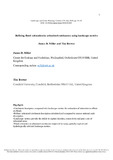JavaScript is disabled for your browser. Some features of this site may not work without it.
| dc.contributor.author | Miller, James D. | |
| dc.contributor.author | Brewer, Timothy R. | |
| dc.date.accessioned | 2018-03-23T16:15:25Z | |
| dc.date.available | 2018-03-23T16:15:25Z | |
| dc.date.issued | 2018-03-22 | |
| dc.identifier.citation | Miller JD, Brewer T. (2018) Refining flood estimation in urbanized catchments using landscape metrics. Landscape and Urban Planning, Volume 175, July 2018, pp. 34-49 | en_UK |
| dc.identifier.issn | 0169-2046 | |
| dc.identifier.uri | https://doi.org/10.1016/j.landurbplan.2018.02.003 | |
| dc.identifier.uri | http://dspace.lib.cranfield.ac.uk/handle/1826/13116 | |
| dc.description.abstract | Flood estimation methods in ungauged basins rely upon generalized relationships between flows and catchment properties. Generally such catchment properties are based on low-resolution national datasets from low density urbanized basins and do not consider location, connectivity and patch size. Such factors are more routinely represented in landscape metrics employed in ecology, and could be particularly useful for representing the diversity of urban land-use. Here, hydrologically relevant landscape metrics are brought together with refined land-use classes and catchment descriptors routinely applied in UK flood estimation methods to estimate the median annual flood (QMED) in order to evaluate the potential role of such metrics. The results show that using higher resolution geospatial data can improve the representation of the urban environment, having particular effects on the delineation of urban water features and catchment area, but not urban extent. Refinement of landscape metrics based on correlations resulted in 12 metrics and 5 catchment descriptors being tested against observed QMED at 18 sites using a weighted least squares regression. The revised equation showed that certain landscape metrics can better represent the hydrological complexity of an urban catchment in a single distributed numerical form, leading to improved estimates of QMED over non-distributed descriptors, for the selected case-study sites. The ability of landscape metrics to express connectivity and relative size and location of urban development promises significant potential for application in urban flood estimation and catchment-scale hydrological modelling. | en_UK |
| dc.language.iso | en | en_UK |
| dc.publisher | Elsevier | en_UK |
| dc.rights | Attribution-NonCommercial-NoDerivatives 4.0 International | * |
| dc.rights.uri | http://creativecommons.org/licenses/by-nc-nd/4.0/ | * |
| dc.subject | Hydrology | en_UK |
| dc.subject | Urban | en_UK |
| dc.subject | Flood | en_UK |
| dc.subject | Landscape metrics | en_UK |
| dc.subject | Catchment descriptors | en_UK |
| dc.subject | Flood estimation | en_UK |
| dc.title | Refining flood estimation in urbanized catchments using landscape metrics, Landscape and Urban Planning | en_UK |
| dc.type | Article | en_UK |
| dc.identifier.cris | 19725336 |
Files in this item
The following license files are associated with this item:
This item appears in the following Collection(s)
-
Staff publications (SWEE) [2825]

